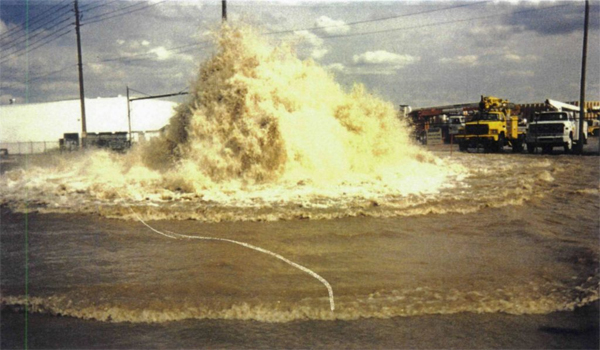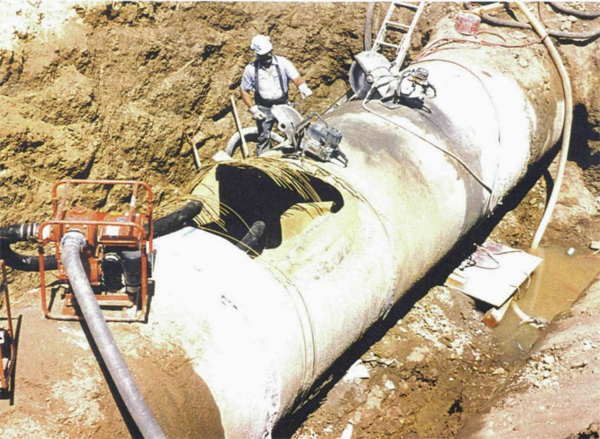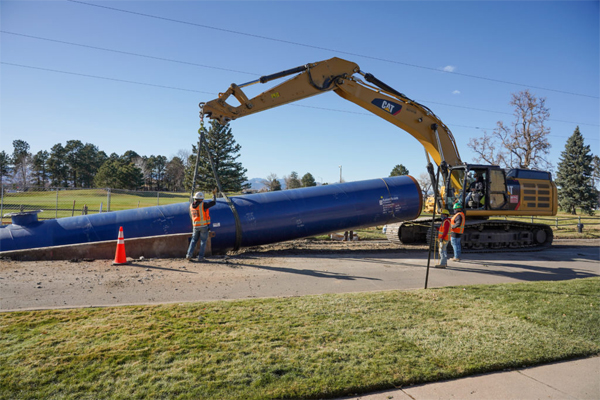Listen Up: How To Prevent Big Water Pipes From Breaking
By Jay Adams, Denver Water
Acoustic monitoring system helps pinpoint problem spots along north Denver pipeline.
Denver Water is keeping a close ear on a 15-mile stretch of water pipeline running across north Denver and replacing two problem areas.
The underground pipeline carries large amounts of water from the Moffat Water Treatment Plant in Lakewood out to people in northeast Denver and Denver International Airport. During the summer irrigation season, when water use is the highest, around 30 to 40 million gallons of water can flow through the pipeline every day.
The pipeline was built in 1977 using prestressed concrete cylinder pipe — a common type of pipe used to deliver water by utilities around the U.S. These pipes consist of a concrete core, a thin steel cylinder with a wire wrapped around it and a mortar coating on the outside.
However, in the years since the pipe was installed, pipes made by one manufacturer in the mid-1970s are now known to experience breaks in the wires, which reduces the structural integrity of the pipe. This defect puts the pipe at higher risk of failure.

The north Denver water pipeline ruptured at East 56th Avenue and Quebec Street in 1997. (Photo credit: Denver Water)
In fact, in 1997, the pipeline did break near East 56th Avenue and Quebec Street. The pipe ruptured and sent water shooting out of the ground and down the street in an industrial area. The pipeline suffered another break in 2008 near I-25 and East 56th Avenue.

A worker prepares to cut out a section of the ruptured water pipe in 1997. You can see the broken strands of wire on the top of the pipe. (Photo credit: Denver Water)
The ruptures highlight why Denver Water takes a proactive approach to inspecting its pipes to locate problems and prioritize when and where to replace sections of pipeline before they fail.
On the north Denver pipeline, Denver Water uses electromagnetic inspection technology as well as an acoustic fiber optic monitoring system designed by Pure Technologies to check for problems in the prestressed concrete cylinder sections of the pipeline.

Crews install an acoustic fiber-optic monitoring system inside the north Denver pipeline in 2014. (Photo credit: Denver Water)
Electromagnetic pipe inspection technology involves draining a pipe and then sending a device through to detect if any sections of the wire have snapped. This technique provides high-quality data, however it does not offer a specific timeframe as to when the wires broke.
In addition to electromagnetic inspections of the pipeline, Denver Water installed the acoustic fiber optic monitoring system in 2014.
The system uses a cable that is inserted into the pipe and “listens” for wire breaks as they happen. When a wire snaps, an alert is sent to a computer monitoring system at the Moffat Treatment Plant.
“The acoustic monitoring system is an important part of Denver Water’s asset management strategy to assess our infrastructure and address problems in the most cost effective way,” said Garrick Thompson, engineering design project manager at Denver Water. “The technology provides continuous monitoring to alert us exactly where a wire break occurs in real time.”
Since 2014, the acoustic monitoring system has detected 543 wire breaks on the pipeline. The breaks are analyzed and then risk assessments are developed to determine if, when and what sections should be replaced.
After a review of the data from electromagnetic and the acoustic fiber optic system identified several problem areas, Denver Water took action on an 800-foot section of the pipe in northwest Denver in 2017. In this location, crews relined the section of prestressed concrete cylinder pipe with steel to make it stronger.

This photo shows the wires around a section of the prestressed concrete cylinder pipe in north Denver. The red circles highlight places where the wire broke This section has been replaced. (Photo credit: Denver Water)
In the fall of 2020, the utility decided to fully replace 2,200 feet of the pipeline in two places — under Tennyson Street, next to Willis Case Golf Course, and along West 50th Avenue, in front of Regis University.

Construction crews install a 50-foot section of steel pipe next to Willis Case Golf Course in northwest Denver in October 2020. (Photo credit: Denver Water)
The two projects involved replacing sections of prestressed concrete cylinder pipe with steel pipe. The steel pipe has a life expectancy of around 100 years. The pipes are 66 inches in diameter with some sections that are 50 feet long and weigh close to 6 tons.
Denver Water continues to monitor and inspect the pipeline for problems and plans to replace all 15 miles of the pipeline that are made from prestressed concrete cylinder pipe in the future.
Crews are expected to wrap up the Tennyson Street replacement work in mid-January 2021 and the 50th Avenue project in late-February.

Large pipes line Tennyson Street before installation. (Photo credit: Denver Water)

Construction workers lower a large valve into a trench at West 50th Avenue and Irving Street in front of Regis University. (Photo credit: Denver Water)

Construction workers carefully lower a large section of pipe into the ground near Willis Case Golf Course. (Photo credit: Denver Water)

The large water pipes are 50 feet long, 66 inches in diameter and weigh 11,500 pounds. (Photo credit: Denver Water)
